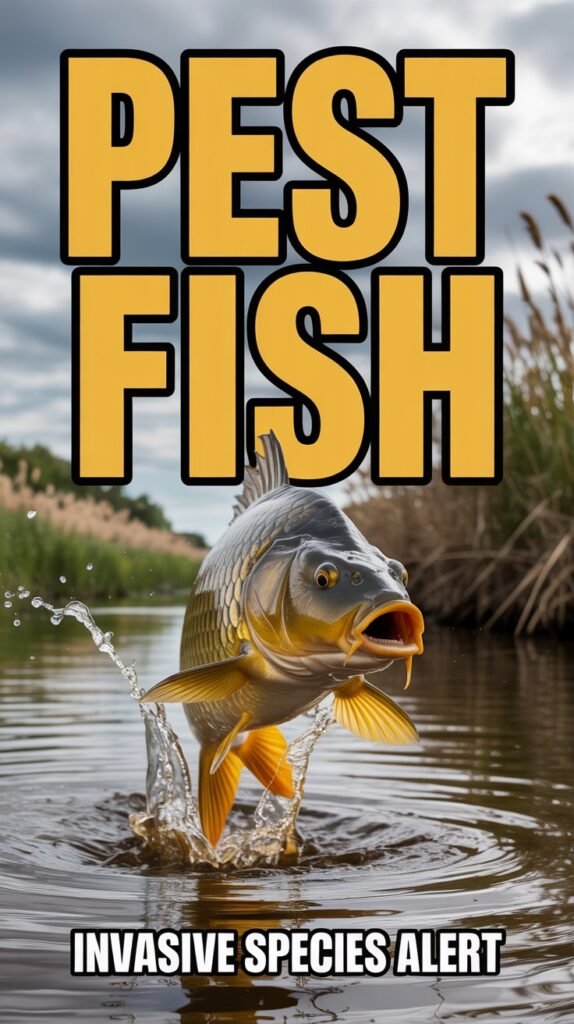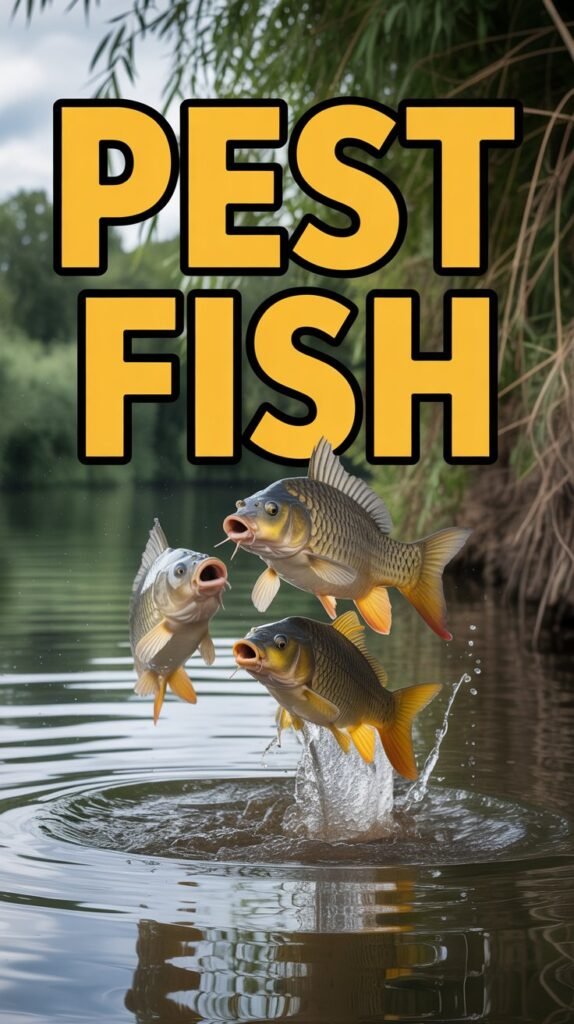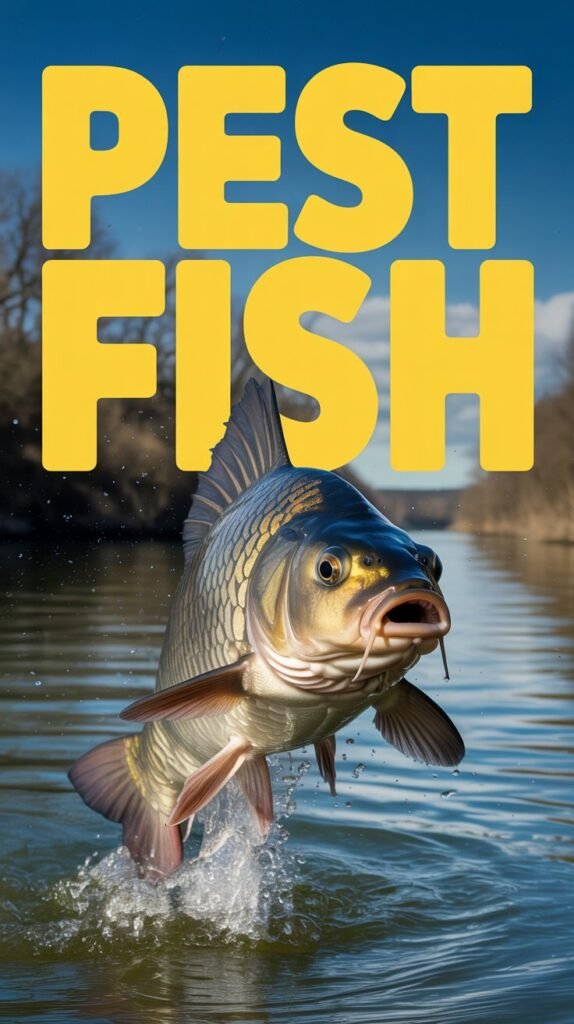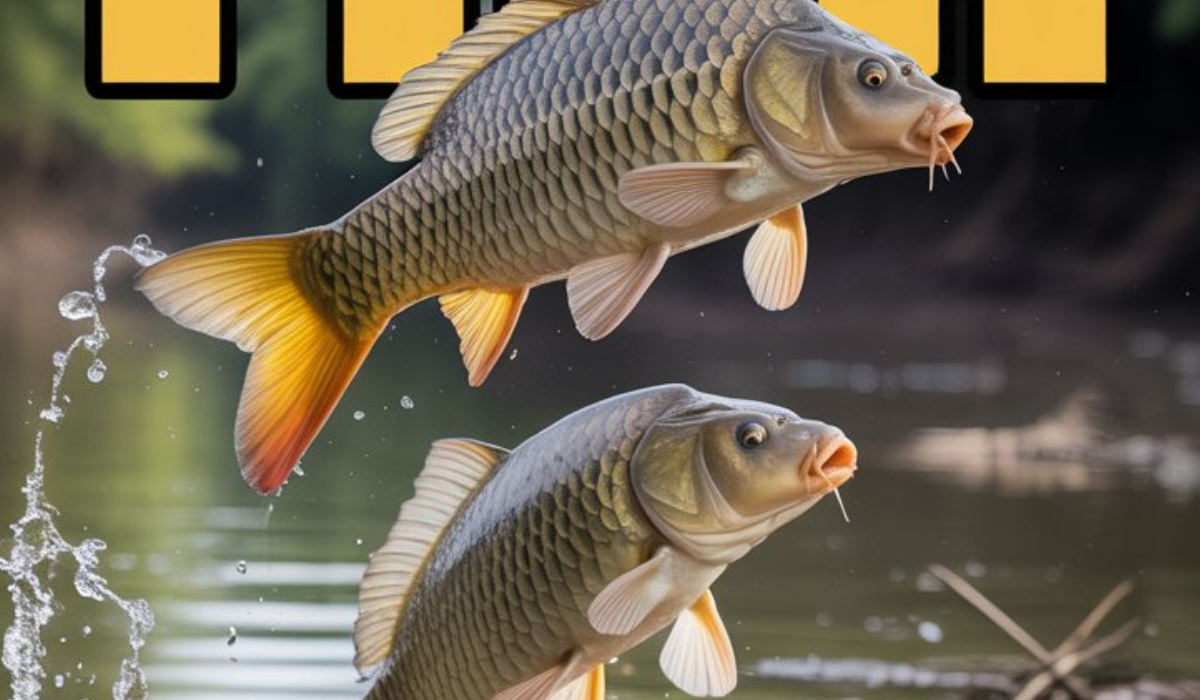The aquatic ecosystem is a delicate balance of species, each playing a vital role in maintaining environmental harmony. However, when certain fish species invade new habitats and disrupt native populations, they become known as pest fish. These invasive or nuisance species can cause severe ecological, economic, and social impacts by outcompeting native species, spreading diseases, and altering habitats.
In this comprehensive guide, we’ll explore what pest fish are, how they spread, the damage they cause, and the best methods to manage and prevent their invasion.
What Are Pest Fish?
Pest fish are species that negatively affect native ecosystems, fisheries, or aquaculture industries when introduced outside their natural range. These fish may be non-native (introduced) or, in some cases, native species that have become overabundant due to environmental changes or human activity.
They are often introduced intentionally (for sport or ornamental purposes) or accidentally (through aquarium releases or water transfers). Once established, pest fish can reproduce rapidly and become extremely difficult to eradicate.
Common Examples of Pest Fish

Across the world, many fish species have earned the title of pest fish due to their destructive impact. Here are some notable examples:
1. Tilapia (Oreochromis spp.)
Originally from Africa, tilapia have been introduced worldwide for aquaculture. However, they are notorious for outcompeting native species for food and breeding space. They also stir up sediment while feeding, reducing water clarity and harming aquatic plants.
2. Carp (Cyprinus carpio)
Common carp are one of the most widespread pest fish globally. They uproot vegetation while feeding and muddy the water, which disrupts the breeding of native fish and destroys aquatic ecosystems.
3. Goldfish (Carassius auratus)
Often released from home aquariums, goldfish grow much larger in the wild than in tanks. They destroy plants, spread parasites, and disturb sediments, making them a serious pest in ponds and rivers.
4. Gambusia (Mosquitofish)
Introduced for mosquito control, these small fish are aggressive and often attack the fins of native species. They have become one of the most invasive fish worldwide.
5. Snakehead Fish (Channa spp.)
Known for their ability to survive out of water for short periods and even move across land, snakeheads are fierce predators that threaten native fish populations wherever they establish.
6. Catfish (Various Invasive Species)
Some catfish species, such as walking catfish (Clarias batrachus), have escaped from aquaculture farms and invaded natural water systems, where they prey on native species and eggs.
7. Suckermouth Catfish (Plecostomus)
Often called “plecos,” these fish are popular in aquariums for their algae-eating habits. However, when released into natural waters, they erode riverbanks by burrowing and outcompete local species.
How Pest Fish Are Introduced
Pest fish can enter ecosystems through several pathways — most linked to human activities. Understanding how they spread is key to controlling future invasions.
1. Aquarium Releases
Unwanted pet fish are sometimes released into local ponds or rivers by owners who don’t realize the ecological damage they cause. Even one pair of fish can establish a breeding population.
2. Aquaculture and Fish Farms
Fish farming often involves non-native species. Escapes from poorly managed ponds or flooding can lead to pest populations in nearby waterways.
3. Recreational Fishing
Some anglers intentionally introduce new fish species to create fishing opportunities, but this often backfires when the fish become invasive.
4. Water Transfers and Flooding
Fish eggs and larvae can travel through water channels, dams, or floods, spreading to new habitats unintentionally.
5. Ballast Water from Ships
In marine systems, ships discharge ballast water that can contain fish larvae or eggs, introducing non-native species into new environments.
Environmental and Ecological Impacts of Pest Fish
The effects of pest fish are wide-ranging and often devastating. They can alter ecosystems both directly and indirectly.
1. Competition with Native Species
Pest fish often compete with native species for food, shelter, and breeding grounds. Because many invasive fish breed more quickly and tolerate poor conditions, they tend to outcompete native fish.
2. Predation
Some pest fish are predators that feed on smaller native fish, eggs, or invertebrates, reducing biodiversity and altering food webs.
3. Habitat Destruction
Species like carp and tilapia disturb sediment while feeding, which uproots aquatic plants and destroys spawning grounds for other species.
4. Spread of Diseases and Parasites
Pest fish can carry and spread pathogens to native fish populations, sometimes wiping out entire species or ecosystems.
5. Decline in Water Quality
By increasing turbidity and nutrient levels, pest fish promote algal blooms and reduce oxygen, making the environment unsuitable for native life.
6. Impact on Aquatic Plants
Pest fish feeding behaviors can remove or damage aquatic vegetation that provides shelter and breeding areas for other species.
Economic Impacts of Pest Fish

The presence of pest fish also brings significant financial consequences:
- Fisheries: Pest fish reduce catches of valuable native or commercial species.
- Aquaculture: They compete for food or transmit diseases to farmed fish.
- Water Management: Increased sediment and vegetation damage can raise maintenance costs for waterways.
- Tourism: Degraded aquatic ecosystems reduce recreational fishing and tourism appeal.
For example, in Australia, carp are estimated to cause millions of dollars in damage annually to freshwater ecosystems and water infrastructure.
Social and Cultural Impacts
Pest fish not only harm the environment and economy but also disrupt traditional fishing practices and cultural connections. In many Indigenous communities, native fish hold deep cultural and spiritual value. When pest fish dominate, these connections weaken as traditional food sources decline.
How to Identify Pest Fish
Accurate identification is crucial before taking any control measures. Here are general signs of pest fish species:
- Rapid population growth and overcrowding
- Aggressive behavior toward other species
- Cloudy or muddy water caused by feeding habits
- Reduced vegetation or altered habitats
- Decrease in native fish sightings or diversity
If you suspect pest fish in your local area, contact local fisheries or environmental authorities to verify and report the species.
Control and Management of Pest Fish
Managing pest fish is challenging because once established, they often spread faster than they can be removed. A combination of physical, biological, and educational strategies is typically used.
1. Mechanical Removal
This involves physically removing fish from the water using nets, traps, or electrofishing. While effective for small populations, it’s labor-intensive and less practical for large infestations.
2. Biological Control
This strategy uses natural predators, parasites, or diseases to reduce pest fish populations. However, it must be used cautiously to avoid introducing new invasive species.
3. Chemical Control
Selective piscicides (fish poisons) like rotenone can eliminate pest fish, but they can also harm non-target species. Therefore, they are used only under strict regulation and in controlled environments.
4. Habitat Modification
Changing environmental conditions to make them less favorable for pest species—such as altering water levels, vegetation, or temperature—can help control populations.
5. Genetic Techniques
Emerging methods like sterile male release programs aim to reduce breeding success. These genetic control approaches show promise for long-term management.
6. Public Awareness and Education
Many pest fish introductions result from public ignorance. Educating aquarists, anglers, and the general public about the risks of releasing fish into the wild is one of the most effective long-term solutions.
Preventing the Spread of Pest Fish

Prevention is always more effective than eradication. Once pest fish establish a population, total removal is nearly impossible. Here’s how you can help prevent the spread:
1. Never Release Aquarium Fish
If you can’t care for your pet fish, rehome them or return them to a pet store. Never release them into rivers, lakes, or ponds.
2. Quarantine New Fish
In aquaculture and aquarium settings, always quarantine new fish for at least two weeks to ensure they aren’t carrying diseases or parasites.
3. Use Native Species
When stocking ponds or aquariums, choose native or locally approved species that won’t harm the ecosystem if they escape.
4. Clean Equipment
Clean boats, nets, and fishing gear between water bodies to prevent transferring eggs or larvae.
5. Report Sightings
If you spot a suspected pest fish in your local waterways, report it to local wildlife or fisheries authorities.
The Role of Aquarium Hobbyists
Aquarium enthusiasts play a huge role in preventing pest fish invasions. Unfortunately, many pest fish in natural environments began as released aquarium pets. Hobbyists should:
- Research fish before purchasing to ensure they won’t outgrow the tank or become aggressive.
- Avoid releasing unwanted fish into the wild.
- Participate in “Don’t Dump That Fish” campaigns that raise awareness about aquarium releases.
- Support responsible aquarium trade practices.
Case Studies: Pest Fish Problems Around the World
1. Common Carp in Australia
Carp were introduced in the 1800s for sport but have since taken over many freshwater systems, destroying vegetation and altering riverbanks. The Australian government is now exploring biocontrol methods, including a carp-specific herpesvirus.
2. Lionfish in the Atlantic
Although marine, lionfish are a classic example of an invasive pest. Released from home aquariums, they now dominate Atlantic reefs, consuming huge amounts of native fish and invertebrates.
3. Snakehead Fish in the U.S.
Native to Asia, snakeheads were introduced to U.S. waterways and quickly became top predators, decimating native species. Their ability to breathe air makes them particularly difficult to control.
Long-Term Management Strategies
1. Monitoring and Research
Ongoing research helps understand pest fish behavior, breeding, and habitat preferences, aiding in targeted control.
2. Collaboration
Governments, conservation groups, and local communities must work together to implement and maintain effective control programs.
3. Legislation
Strict regulations on fish imports, sales, and releases are necessary to prevent new invasions.
4. Restoration of Native Ecosystems
Rehabilitating degraded habitats can help native species recover and naturally resist pest fish dominance.
Conclusion
Pest fish are one of the biggest threats to global aquatic biodiversity. They alter ecosystems, harm native species, and cause economic and cultural damage. While eradication is often impossible once they establish, prevention, public awareness, and responsible management can make a significant difference.
Whether you’re a fishkeeper, angler, or environmental advocate, you have a role to play in preventing the introduction and spread of pest fish. Responsible fish ownership, regular monitoring, and supporting conservation efforts ensure our aquatic environments remain balanced and healthy for generations to come.
Frequently Asked Questions (FAQs)
1. What are pest fish?
Pest fish are invasive or nuisance species that harm native ecosystems, reduce biodiversity, and negatively affect water quality, fisheries, or aquaculture industries.
2. How do pest fish spread?
They spread through aquarium releases, aquaculture escapes, recreational fishing introductions, ballast water discharge, and flooding.
3. Why are pest fish dangerous?
They outcompete native species for food and habitat, spread diseases, destroy vegetation, and disrupt aquatic ecosystems.
4. What are some common examples of pest fish?
Common examples include carp, tilapia, goldfish, snakehead, mosquitofish, and suckermouth catfish.
5. Can pest fish be completely eradicated?
In most cases, complete eradication is very difficult. However, their populations can be managed through physical, biological, or chemical control methods.
6. How can aquarium owners help prevent pest fish problems?
Never release aquarium fish into the wild. Rehome them, donate them, or contact pet stores for return options.
7. What happens if I release pet fish into local waterways?
Released fish can become invasive, breeding uncontrollably and harming native ecosystems. It is also illegal in many countries.
8. Are pest fish only a problem in freshwater environments?
No. Both freshwater and marine environments can be affected. For example, lionfish are marine pest fish in the Atlantic Ocean.
9. How do authorities control pest fish populations?
Authorities use mechanical removal, biological control, chemical treatment, and public education campaigns to manage pest fish.
10. What can I do if I spot pest fish in my local area?
Take a photo, record the location, and report it to your local fisheries or environmental department for verification and management.

